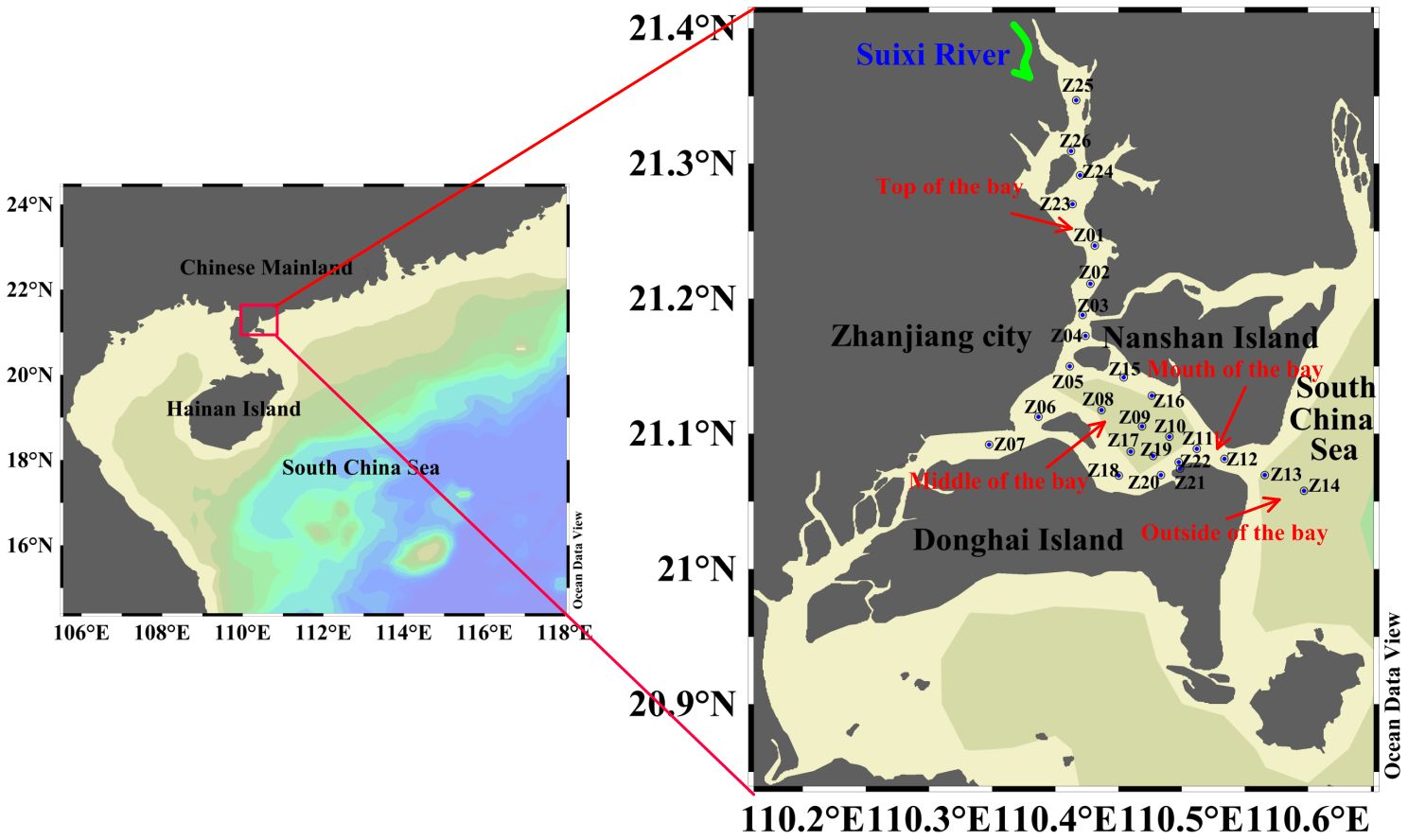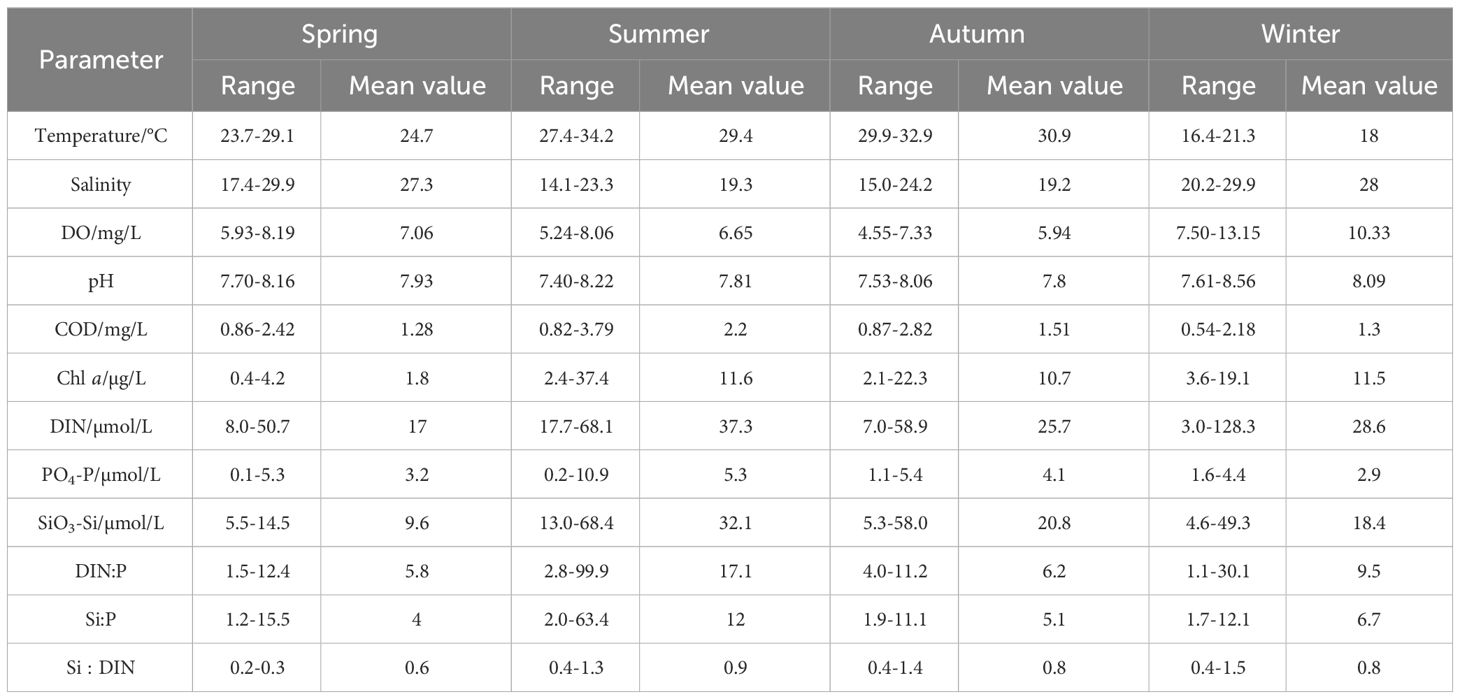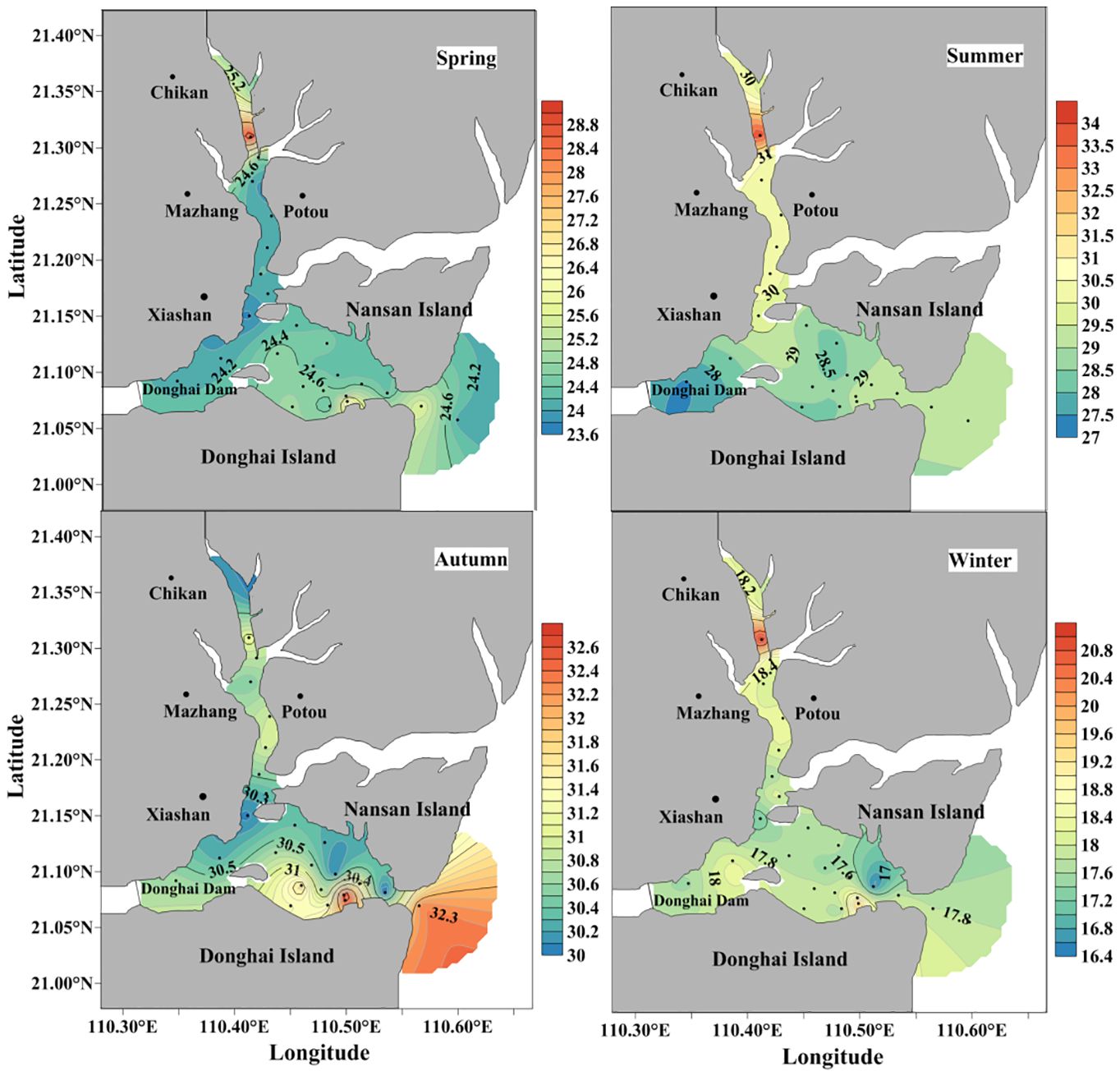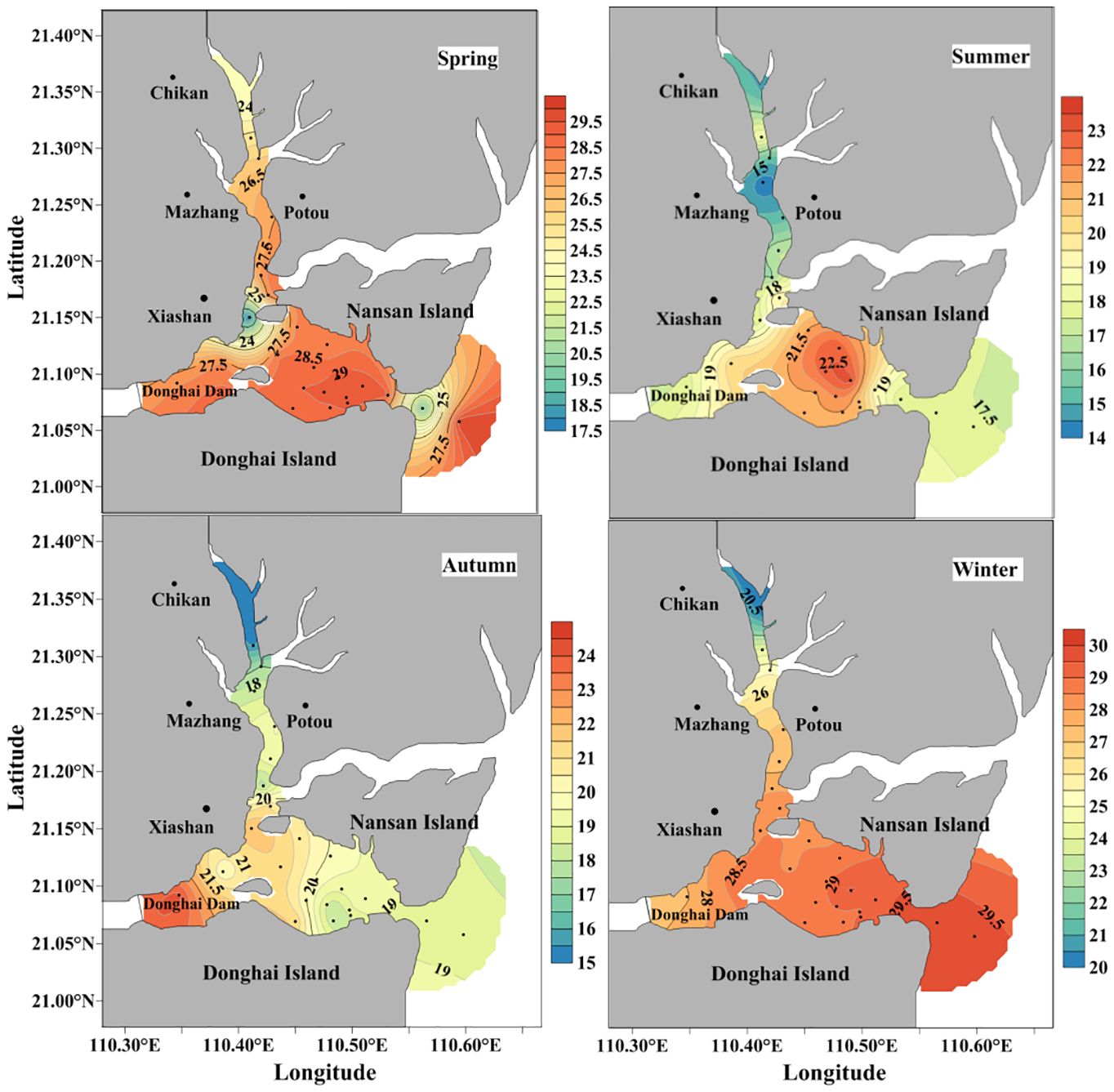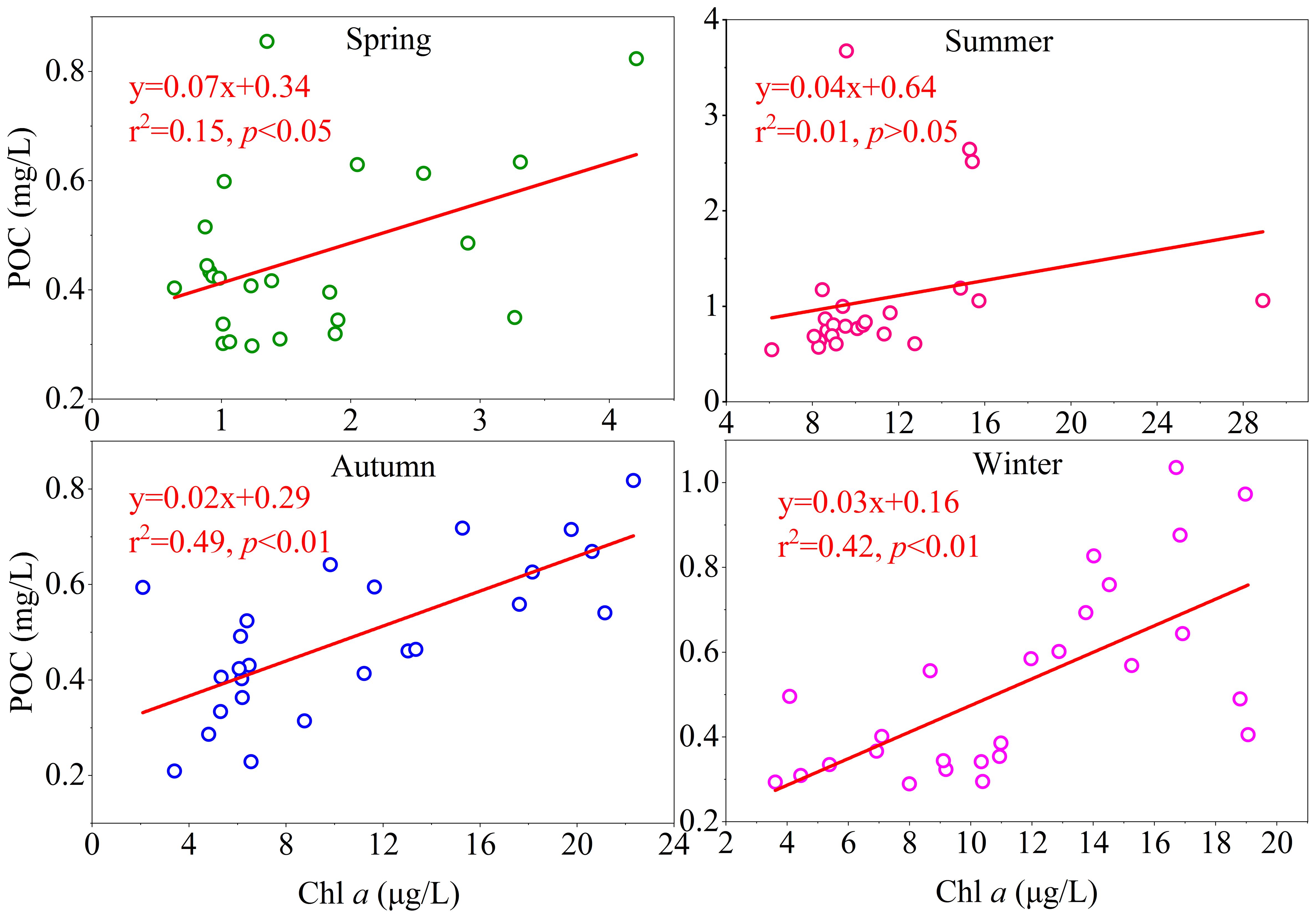- 1College of Ocean and Meteorology, Guangdong Ocean University, Zhanjiang, China
- 2Key Laboratory for Coastal Ocean Variation and Disaster Prediction, Guangdong Ocean University, Zhanjiang, China
- 3Key Laboratory of Climate, Resources and Environment in Continental Shelf Sea and Deep Sea of Department of Education of Guangdong Province, Guangdong Ocean University, Zhanjiang, China
Based on on-site survey data from 26 stations in the surface seawater of Zhanjiang Bay in April (spring), July (summer), September (autumn), and December (winter) of 2017, the spatial distribution characteristics of chlorophyll a (Chl a) and nutrients in the surface seawater of Zhanjiang Bay in different seasons were analyzed, and the regulatory mechanism of chlorophyll a spatiotemporal changes was discussed. The results showed that the Chl a concentrations in the surface water of Zhanjiang Bay are 0.44–37.43 μg/L, and are highest in summer and lowest in spring (summer: 11.6 µg/L; winter: 11.5 µg/L; autumn: 10.7 µg/L; spring: 1.8 µg/L). The spatial distribution of surface seawater Chl a in different seasons shows an opposite trend to the spatial distribution of nutrients. The study revealed that the low Chl a concentration in spring is mainly limited by SiO3-Si, while the high Chl a concentration in winter is closely related to climate conditions and coastal currents. This study suggests that based on the influence of monsoon climate and land rainfall erosion, the particulate organic carbon (POC) in Zhanjiang Bay in spring and summer is derived from land-based inputs, while in autumn and winter, the POC in the surface water of Zhanjiang Bay is mainly derived from in situ phytoplankton production. The dominant factors affecting the distribution of Chl a in the surface water of Zhanjiang Bay vary in different seasons, and are comprehensively influenced by terrestrial nutrient transport, artificial aquaculture, climate conditions, hydrodynamic conditions in the bay, and the coastal current of western Guangdong outside of the bay. The results of this study can provide scientific basis for improving the environment of Zhanjiang bay.
1 Introduction
Estuaries and bays are the most important areas of land–sea interaction. Terrestrial biogenic elements and organic matter brought by rivers enter the sea in the estuary area, providing the material for primary marine production (Ogawa et al., 2021). Under the combined influence of land runoff and ocean tides, the hydrological and hydrodynamic conditions in estuarine areas can vary considerably, and the biogeochemical processes related to nutrient cycling and primary productivity in estuarine areas are complex (Cai et al., 2021). Therefore, studying the relationship between phytoplankton biomass (chlorophyll a, herein Chl a) and other factors such as nutrients in estuarine and bay areas is of great significance for understanding the biogeochemistry of estuarine areas. Chl a concentration is an important basis for estimating marine living resources, which is of great significance for the development of marine fishery resources (Liu et al., 2019). In addition to being directly affected by the phytoplankton community composition, phytoplankton biomass is also affected by nutrient concentration and structure (Anderson et al., 2022; Niveditha et al., 2022), climate (Golubkov et al., 2021), hydrodynamic conditions (Wang et al., 2021), ocean circulation (Chen et al., 2021; Komorita et al., 2021), and other factors. The Chl a concentration in water is an important indicator to characterize phytoplankton biomass, which to some extent reflects the ability of phytoplankton to produce organic carbon through photosynthesis (Duan et al., 2014). The POC/Chl a ratio can characterize the contribution of non-living particulate organic carbon to total particulate organic carbon (Duan et al., 2014; Chen et al., 2021).
Zhanjiang Bay is located on the northwest continental shelf of the South China Sea and is an important center for aquaculture production and export in China (Li et al., 2019; Lao et al., 2022). Marine aquaculture in Zhanjiang Bay includes shellfish (e.g., oysters), fish, shrimp, and crabs. Indeed, the area is known as the “Shrimp Capital of China” because the area under aquaculture, productions of seedlings, yield, and export of shrimp are all the highest in the country (Wu and Yang, 2011). The seawater in the Zhanjiang Bay area is mainly composed of a mixture of Suixi River water and seawater from outside of the bay. There is only a narrow waterway (~2 km) at the mouth of the bay that communicates with the open sea area in the northwest of the South China Sea (Figure 1). In recent years, the rapid development of port industry in Zhanjiang Bay has led to an increasing load of industrial pollution, ship pollution, and aquaculture and domestic pollutants entering the sea. Seasonal changes in surface runoff have had an important impact on the nutrient structure of the sea area (Shi et al., 2015; Zhang et al., 2021; Zhou et al., 2021).
In response to the increasingly severe eutrophication in Zhanjiang Bay, previous studies have examined the distribution of Chl a and nutrients in the area. Zhang et al. (2012) used principal component analysis to explore the relationship between Chl a and major environmental factors in Zhanjiang Bay during 2009. Their results showed that Chl a concentration exhibited a seasonal pattern (summer > winter > spring > autumn), with a decrease from outside to the inside of the bay, and that the environmental factors affecting Chl a in Zhanjiang Bay during different seasons are more complex than in other areas. Shi et al. (2015) used data collected in 2011 to explore the impact of environmental factors on the eutrophication status of Zhanjiang Bay. They showed that the low salinity and high concentration of pollutants in Suixi River discharge and land-based pollution discharge have a major impact on eutrophication in Zhanjiang Bay. Zhang et al. (2021) conducted surveys during the dry, normal, and rainy seasons in Zhanjiang Bay in 2019, and found that the seasonal dynamics of total dissolved phosphorus (TDP) in the coastal areas of Zhanjiang Bay are influenced mainly by land-based discharge. The concentration of TDP decreases from the top of Zhanjiang Bay to the mouth of the bay. Fu et al. (2020) studied the geochemical characteristics of nutrients in Zhanjiang Bay during spring. They showed that the bay was affected by industrial drainage and river discharge, as well as by coastal currents in western Guangdong. The concentrations of nutrients inside and outside of the bay were relatively high, while the concentrations of nutrients at the mouth of the bay were relatively low. Other studies have shown that the distributions of phosphates, silicates, and nitrates in the Zhanjiang Bay area are affected by land-based discharge (Fu et al., 2020; Zhang et al., 2020). Recent studies on Chl a in Zhanjiang Bay have mainly focused on its relationship with water eutrophication, land-based discharge, and the spatiotemporal distribution of nutrients. However, few studies have analyzed spatial and seasonal variations of Chl a in Zhanjiang Bay in relation to nutrients, climate, hydrodynamic conditions, and ocean circulation.
In this study we analyze the spatial and seasonal variations of Chl a and nutrients in Zhanjiang Bay using survey and sampling data collected from 26 stations in 2017. We analyze the relationship between Chl a in the surface water of Zhanjiang Bay and environmental factors such as nutrient concentrations, POC, hydrodynamic conditions, and offshore water masses. The results may provide a scientific basis for the management of eutrophication and the marine environment in Zhanjiang Bay and similar bays elsewhere.
2 Materials and methods
2.1 Sampling period and station locations
The survey and sampling were conducted in Zhanjiang Bay during four cruises in April (spring), July (summer), September (autumn), and December (winter) of 2017. A total of 26 sampling stations were set up to investigate and analyze the physical and chemical characteristics of the water body and Chl a. The locations of sampling stations are shown in Figure 1.
2.2 Sample collection and analysis
Water samples from each station were collected at a depth of 0.5 m below the water surface. Organic glass water samplers were used in situ to collect surface water for measurements of nutrient concentrations and Chl a. The temperature and salinity of the seawater were measured simultaneously using a conductivity–temperature–depth sensor (CTD) (SBE911, Seabird). Water was pre-filtered with a sieve before sampling to remove impurities and most zooplankton from the water. The water samples (0.2–1.0 L) were then filtered with a GF/F membrane (interception efficiency equivalent to 0.65 μm) as soon as possible. The membrane was then folded in half, wrapped in aluminum foil, labeled, and stored at –20°C until analysis.
The nutrient concentration was measured using a Skalar automatic nutrient analyzer (Skalar-Analytical, Breda, the Netherlands), and water sample analysis was conducted according to the “Ocean Survey Specification-Observation of Seawater Chemical Elements” and the “SKALAR SAN++ Automatic Nutrient Analyzer Operation Manual”. Nitrate (NO3-N), nitrite (NO2-N) and ammonium (NH4-N) concentrations were measured using the cadmium copper column reduction-diazo azo method, the diazo azo method and the indigo carmine method, with detection limits of 0.1, 0.02, 0.05μmol/L, respectively. Phosphate (PO4-P) with the phosphorus molybdenum blue method, and silicate (SiO3-Si) with the silicon molybdenum blue method, with detection limits of 0.1, 0.03μmol/L, respectively. The Chl a concentration in seawater was measured using the fluorescence method according to the “Marine Survey Specification-Marine Biological Survey”, with detection limits of 0.6ug/L. The filter membrane was extracted with 90% acetone and placed in a low-temperature refrigerator at –20°C for 24 h. The extraction solution was determined using a Turner Designs Fluorometer (Model 10AU). The concentration of inorganic nitrogen (DIN) is taken as the sum of the NO3-N, NO2-N, and NH4-N concentrations.
3 Results and analysis
3.1 Seasonal variations of water temperature and salinity
The surface water temperature and salinity data are shown in Table 1. The water temperature was in the range 16.4–34.2°C, being highest in autumn and lowest in spring: autumn (30.9°C), summer (29.4°C), spring (24.7°C), winter (18.0°C). Station Z26 is located near the site of discharge of cooling water from a thermal power plant (Figure 2). The surface water temperature at this station is 3–4°C higher than the surrounding area in each season. Except for Z26, the water temperature shows little change within a single season.
The surface water salinity was in the range 17.4–29.9. Seasonal changes in discharge from the Suixi River, the monsoon climate, and replenishment by offshore water masses mean that the amount of fresh water entering Zhanjiang Bay varies seasonally. The salinity decreases from winter to autumn: winter (28.0), spring (27.3), summer (19.3), autumn (19.2). The salinity shows a gradual increase from the top of the bay to the middle, and then outside of the bay, indicating that the survey area is a transition zone from freshwater to seawater (Figure 3).
3.2 Spatiotemporal distribution of Chl a
To obtain the spatiotemporal distribution characteristics of environmental factors such as Chl a and nutrients, Kriging interpolation method in Surfer 13 was adopted in this study for spatial interpolation, and analyzed using linear component analysis. The spatiotemporal distribution of surface water Chl a in Zhanjiang Bay is shown in Figure 4. Many studies have shown that under the influence of land-based pollution discharge and runoff, the Chl a concentration shows a decreasing trend from inside to outside of the bay (Justić et al., 1995a; Lucas et al., 2023). In spring and summer, the overall spatial distribution of surface Chl a in Zhanjiang Bay shows an increasing trend from inside to outside of the bay. In autumn and winter, due to the influence of aquaculture near Donghai Island, the Chl a concentration near Donghai Island is relatively high. In autumn and summer, at station Z6, the Chl a concentration are 21.15µg/L and 18.97µg/L, respectively, which are the highest concentration in the middle of the bay. The average concentration of Chl a is highest in outside of the bay in autumn, while it is highest in the middle of the bay in winter, and the average concentration from the top of the bay to outside of the bay as follows: autumn (11.44、8.68、15.23、17.63µg/L), winter (8.17、14.28、11.82、6.15µg/L).
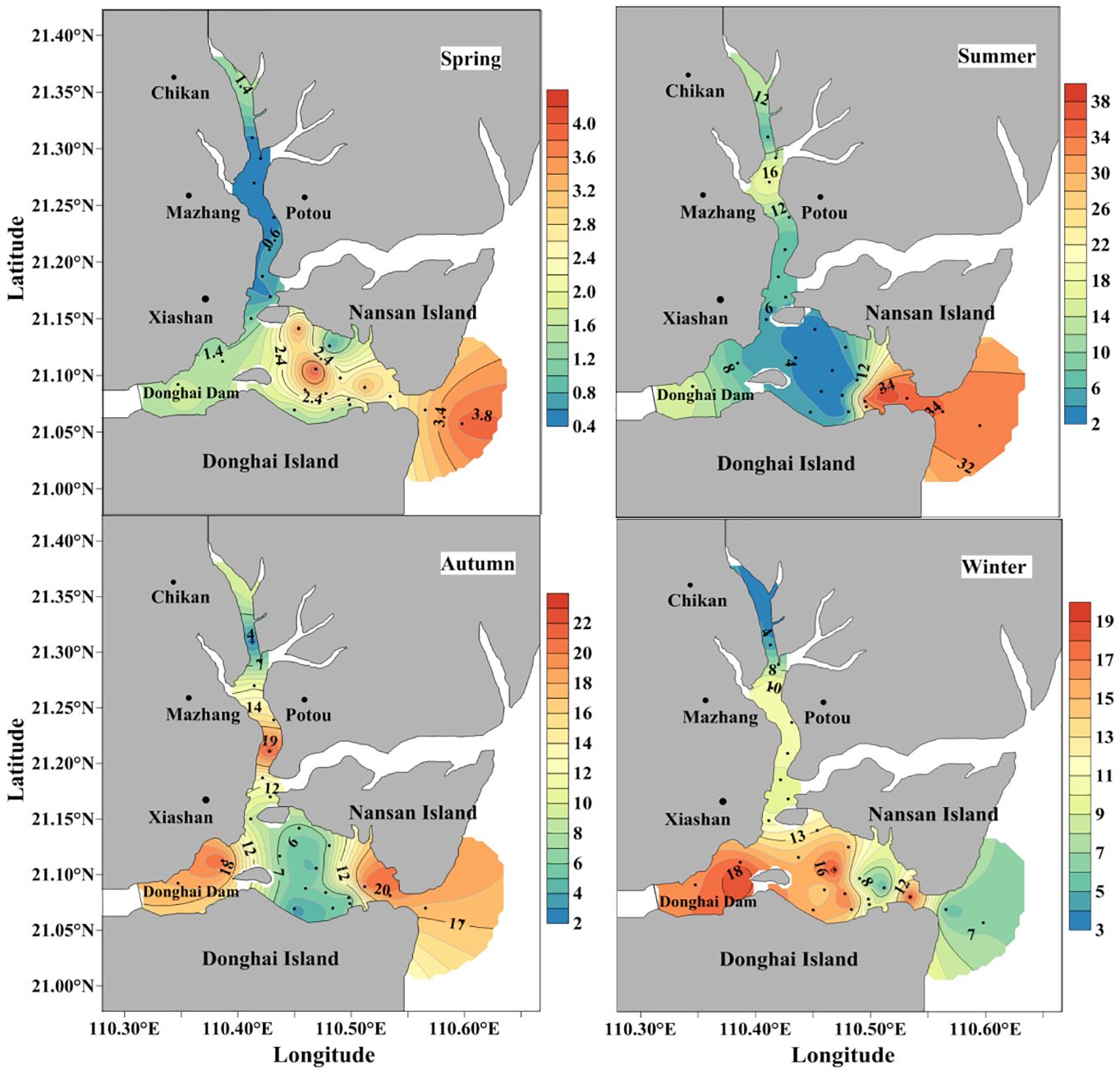
Figure 4 Spatiotemporal distribution of chlorophyll a concentrations (µg/L) in the surface water in Zhanjiang Bay.
The Chl a concentration is highest in summer and lowest in spring: summer (11.6 µg/L), winter (11.5 µg/L), autumn (10.7 µg/L), spring (1.8 µg/L). The range of Chl a concentration during the survey period is 0.44–37.43 µg/L, with the lowest value occurring in spring at station Z24 near the thermal power plant, and the highest value in summer at Z11 near the bay mouth.
In spring, the concentration of Chl a in the surface water was 0.44–4.23 µg/L. The highest value was recorded at station Z09 in the bay. Except for stations Z09, Z15, and Z16, and station Z14 outside of the bay, the concentration at other stations is <3.50 µg/L. Stations Z26 to Z04 at the top of the bay yield concentrations of <1 µg/L.
In summer, the concentration of Chl a in the surface water varies from 2.36 to 37.43 µg/L. Station Z11 recorded the highest value of 37.43 µg/L. The concentrations at stations Z12, Z21, and Z22, near the bay mouth, are 35.46, 27.52, 36.40 µg/L, respectively, much higher than those at other stations. The concentrations at stations Z09, Z10, and Z17, middle of the bay, are relatively low.
In autumn, the Chl a concentration is 2.1–22.3 µg/L, with the highest value at station Z02. The concentrations at stations Z06 and Z07, near the Donghai Dam, and Z11, Z12, and Z13, near the bay mouth, are relatively high (21.15, 18.16, 20.62, 19.76, and 17.63 µg/L, respectively). The concentrations at stations Z18, Z17, and Z09 in the bay are relatively low.
In winter, the Chl a concentration is 3.6–19.1 µg/L, with the lowest value located at station Z25, at the top of the bay, and the highest value at station Z12 near the bay mouth. The top of the bay shows low concentrations, with an average value of 8.17 µg/L.
3.3 Spatiotemporal distribution of nutrients
3.3.1 Spatiotemporal distribution of total dissolved inorganic nitrogen
Total dissolved inorganic nitrogen (DIN) comprises NO2-N, NO3-N, and NH4-N. The spatial distribution of surface water DIN in Zhanjiang Bay has similar characteristics in all four seasons (Figure 5), showing a gradually decreasing trend from the top to the middle, and then to the outside of the bay. The top of the bay shows high values in all four seasons. In spring and winter, the top of the bay shows a strong gradient in DIN concentrations, whereas a weak gradient exists from the middle to the outside of the bay. In spring and winter, the concentration gradients at the top of the bay are 16.47–50.67 µmol/L and 28.54–128.34 µmol/L, respectively, and the concentration gradients from the middle to the outside of the bay are 8.01–18.61 µmol/L and 2.99–27.69 µmol/L, respectively. In summer and autumn, the concentration gradient in the bay is relatively strong, ranging from17.70–68.14 µmol/L and 6.96–58.92µmol/L, respectively. The average DIN concentration is 37.3 µmol/L in summer, 28.6 µmol/L in winter, 25.7 µmol/L in autumn, and 17.3 µmol/L in spring. The highest value of 128.34 µmol/L was recorded in winter at station Z25, which is an important oyster breeding site at the top of the bay. The lowest value of 2.99 µmol/L was recorded in winter at station Z07 near the Donghai Dam. Overall, the DIN concentration is the highest at the top of the bay. The DIN concentration shows an inverse correlation with salinity, indicating a strong terrestrial input of DIN to the surface water in Zhanjiang Bay.
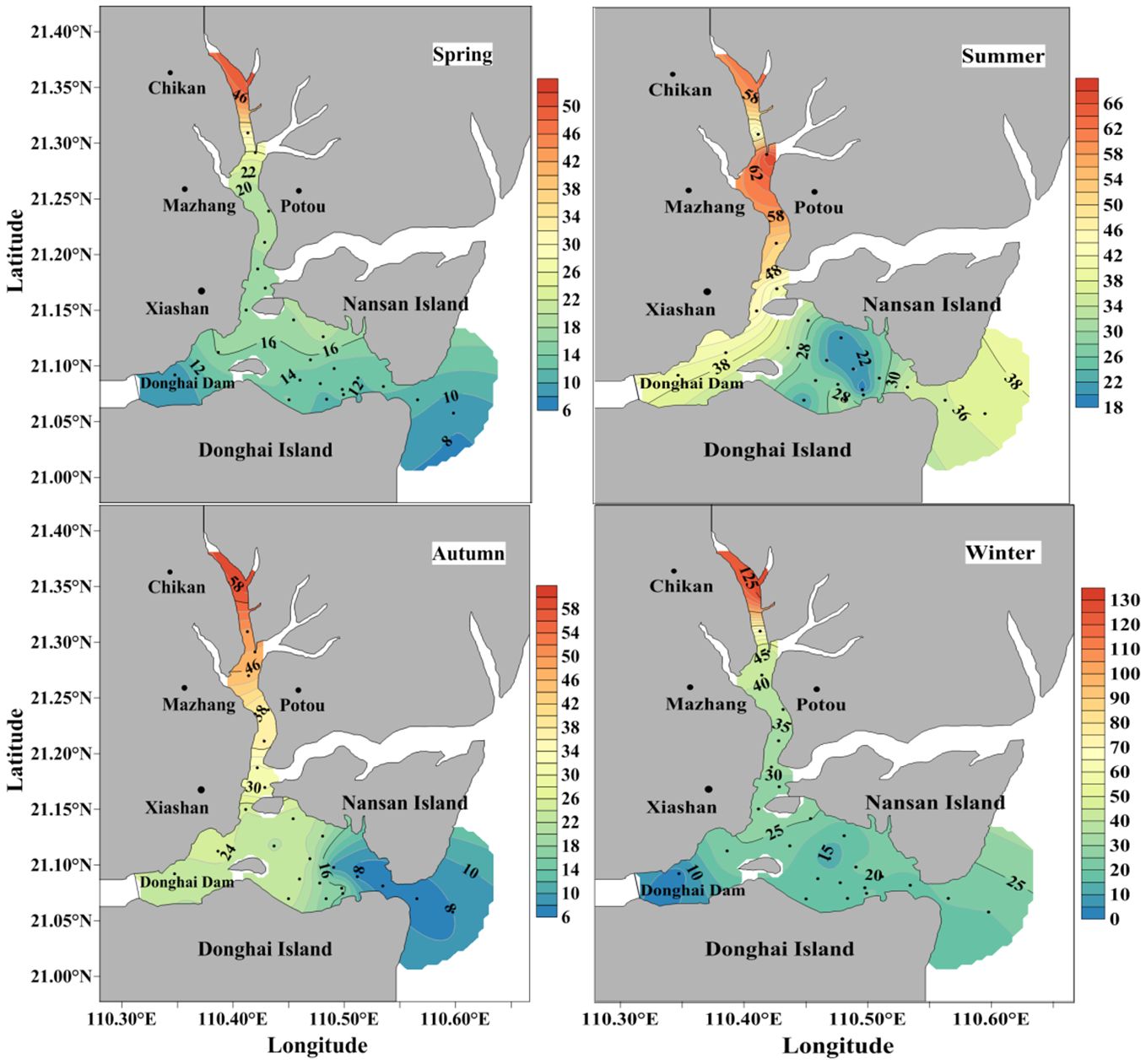
Figure 5 Spatiotemporal distribution of DIN concentration (µmol/L) in the surface water in Zhanjiang Bay. .
3.3.2 Spatiotemporal distribution of active phosphate
The spatial distribution of the concentration of active phosphate (PO4-P) in surface water of Zhanjiang Bay is similar in all four seasons (Figure 6), showing a gradual decrease from the top to the middle and then the outside of the bay, and the average concentrations from the top to the middle and then the outside of the bay in four seasons are as follows: spring (4.47、3.18、1.68、0.50 µmol/L), summer (6.00、5.94、0.32 µmol/L), autumn (5.07、4.20、1.84、1.12µmol/L), winter (3.99、2.60、1.92、1.65 µmol/L).There is a minor decrease in PO4-P concentration from the top to the middle of the bay, and a strong decrease from the middle to the outside of the bay. Stations Z06 and Z07 near the Donghai Dam are affected by aquaculture, and PO4-P concentrations are relatively high in spring, summer, and autumn. The PO4-P concentrations in spring and summer are highest at station Z07 (5.29 and 10.93 µmol/L, respectively). In winter, the scale of seawater aquaculture near the Donghai Dam is limited by temperature, and the maximum concentration of PO4-P is 4.38µmol/L at station Z26 at the top of the bay. The concentration of PO4-P near the bay mouth (Z12) is much lower in summer (0.47µmol/L) than in other seasons. Overall, the average concentration of PO4-P in the surface water of Zhanjiang Bay is highest in summer and lowest in spring (minimum value, 0.09 µmol/L at station Z14 outside of the bay): summer (5.3 µmol/L), autumn (4.1 µmol/L), spring (3.2 µmol/L), winter (2.9 µmol/L).
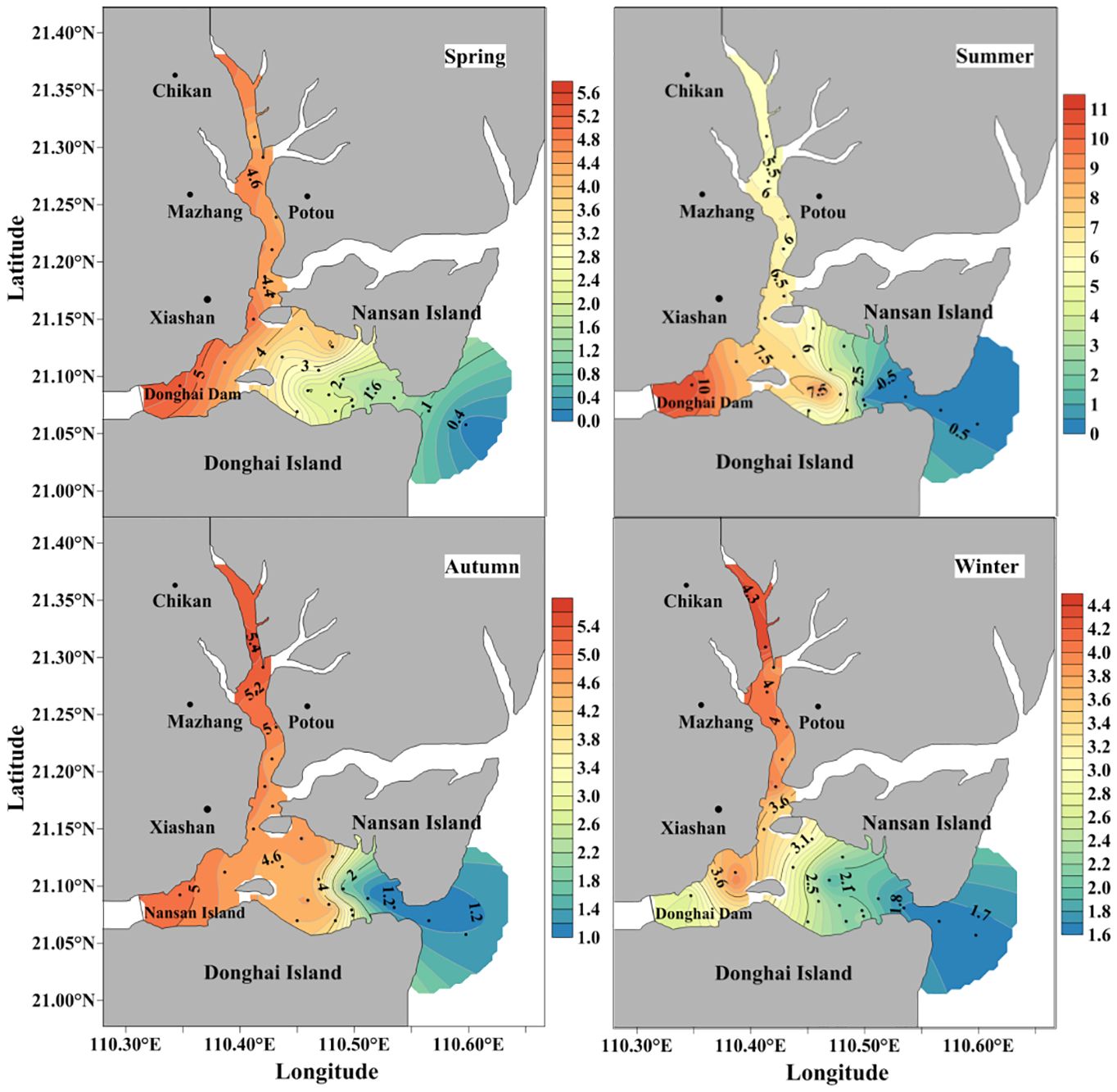
Figure 6 Spatiotemporal distribution of PO4-P concentration (µmol/L) in surface water in Zhanjiang Bay.
3.3.3 Spatiotemporal distribution of active silicate
The spatial distribution of active silicate (SiO3-Si) concentration in the surface water of Zhanjiang Bay is similar in summer, autumn, and winter (Figure 7), showing a gradually decreasing trend from the top to the middle and then the outside of the bay. In spring, the SiO3-Si concentration is 5.52–14.54 µmol/L. It is relatively low at stations Z01, Z02, and Z03 at the top of the bay (5.52, 5.71, and 5.86 µmol/L, respectively). However, the concentrations at Z12, Z13, and Z14 outside of the bay are relatively high (11.64, 13.97, and 14.46 µmol/L, respectively). Overall, the SiO3-Si concentration in spring is significantly lower from the top of the bay to outside of the bay than in other seasons.
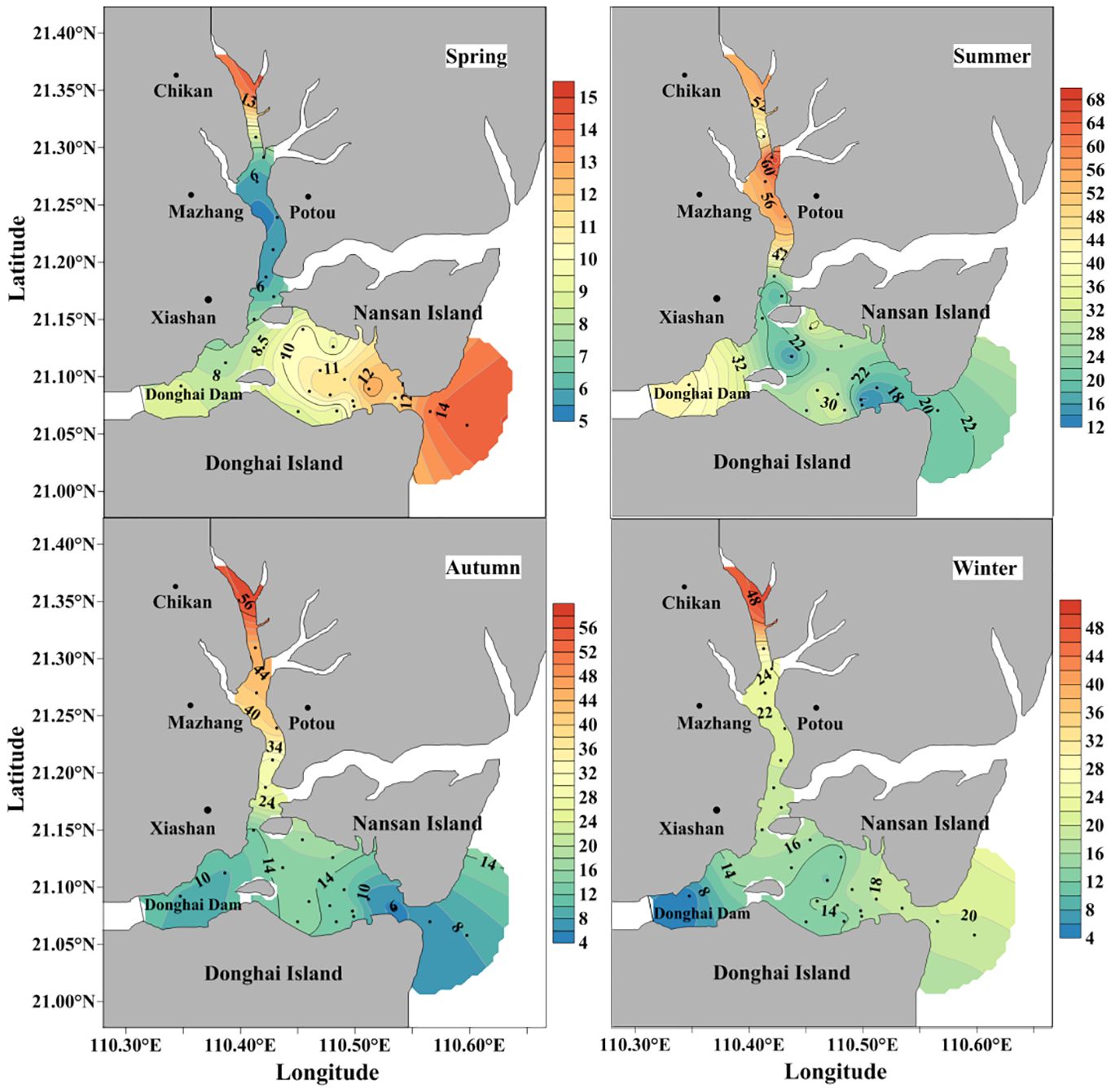
Figure 7 Spatiotemporal distribution of SiO3-Si concentration (µmol/L) in surface water in Zhanjiang Bay.
In summer, the concentration of SiO3-Si varies from 13.04 to 68.45 µmol/L. The concentrations of SiO3-Si in the surface water at stations Z24, Z23, Z01, and Z02, at the top of the bay, are relatively high (68.45, 56.30, 57.45, and 47.22 µmol/L, respectively). However, the concentrations at Z22, Z11, and Z12 outside of the bay are relatively low (17.95, 16.47, and 13.04 µmol/L, respectively). The distribution in autumn is the same as in summer, with a relatively high concentration of SiO3-Si at the top of the bay and a relatively low concentration at the mouth and outside of the bay. In autumn, there are low values at Z06 and Z07 near the Donghai Dam (9.64 µmol/L at both stations). The highest values in winter are at Z25 and Z26 at the top of the bay (49.30 and 29.98 µmol/L, respectively). The lowest value is at Z07 near the Donghai Dam (4.60 µmol/L). The average SiO3-Si concentration in Zhanjiang Bay is 32.1 µmol/L in summer, 20.8 µmol/L in autumn, 18.4 µmol/L in winter, and 9.6 µmol/L in spring.
3.4 Correlation between Chl a and physicochemical factors
The Chl a concentration reflects the abundance of marine phytoplankton biomass (Duan et al., 2014). Generally, Chl a is influenced by environmental factors such as nutrients, temperature, salinity, light, and hydrodynamic processes (Minu et al., 2020). As a typical semi-enclosed bay, Zhanjiang Bay is jointly affected by the input of terrestrial freshwater and the transport of offshore water masses, resulting in spatial differences in nutrients, temperature, salinity, and hydrodynamic forces among different areas inside of the bay. There is a seasonal variation in the average value of Chl a in the surface water of Zhanjiang Bay, with the highest value in summer and the lowest in spring. Results of a correlation analysis of four seasonal environmental factors and Chl a in Zhanjiang Bay in 2017 are given in Table 2.
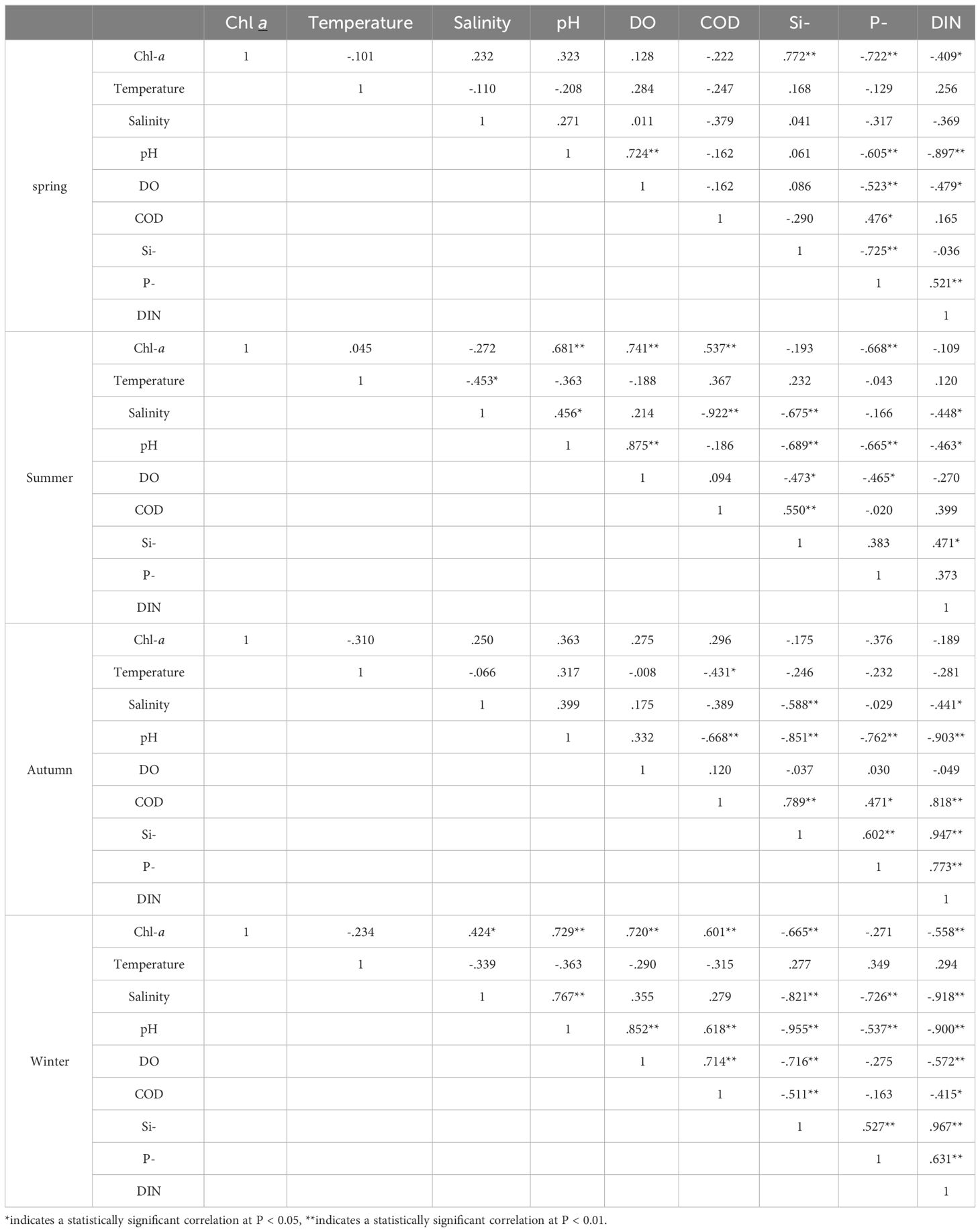
Table 2 Correlation coefficients between chlorophyll a and physicochemical factors in the surface water in Zhanjiang Bay.
In spring, the average concentration of Chl a in the surface water of Zhanjiang Bay is the lowest level throughout the year. Chl a is significantly positively correlated with SiO3-Si (r = 0.772), negatively correlated with PO4-P (r = –0.722), and negatively correlated with DIN (r = –0.409).
In summer, the average concentration of Chl a in the surface water of Zhanjiang Bay reached its highest value throughout the year. Chl a was significantly positively correlated with pH (r = 0.681), dissolved oxygen (DO) (r = 0.741), and chemical oxygen demand (COD) (r = 0.537), and negatively correlated with PO4-P (r = –0.668).
In autumn, the correlation between Chl a concentration and various nutrient elements is not significant. Autumn is the start of the dry season for the catchment of the Suixi River in Zhanjiang Bay, with a decrease in terrestrial nutrients. In summer, phytoplankton proliferate and consume excessive nutrients, resulting in a decrease in nutrients in the water.
In winter, the average Chl a concentration in the surface water of Zhanjiang Bay is second only to that in summer. Chl a is significantly positively correlated with pH (r = 0.729), DO (r = 0.720), and COD (r = 0.601), and negatively correlated with SiO3-Si (r = –0.665) and DIN (r = –0.558). In winter, the average Chl a concentration is still relatively high. Similar to summer, Chl a concentration is significantly positively correlated with pH, DO, and COD, all nutrients show a significant negative correlation with salinity, indicating dilution and mixing in the survey area.
3.5 General relationship between Chl a and POC
Particulate organic carbon in the ocean originates either from terrestrial material carried by runoff, is transported into the ocean through the atmosphere, or from in situ production in the marine environment (Savoye et al., 2012; Le et al., 2017). The Chl a concentration is the most commonly used proxy for the phytoplankton carbon biomass (Duan et al., 2014). The POC/Chl a ratio can also serve as an effective indicator of whether organic matter is derived from fresh local inputs (i.e. in situ phytoplankton production) or terrestrial particle inputs. A POC/Chl a value of >200 indicates that POC comes mainly from terrestrial transport; a POC/Chl a value of 20–200 indicates that POC is composed mainly of newly produced organic matter from phytoplankton (Chen et al., 2021). The station data show significant seasonal variations in the average concentration of Chl a and POC/Chl a in the surface seawater of Zhanjiang Bay in 2017 (Figure 8). In spring, the average concentration of Chl a in surface water is the lowest, with an average POC/Chl a value of >200. In addition, there is a weak positive correlation between POC and Chl a in spring (R2 = 0.15, P < 0.05; Figure 8), indicating that POC in Zhanjiang Bay is mainly affected by terrestrial inputs in spring. In summer, the average concentration of Chl a in surface water is the highest, with POC/Chl a values of <200 (Figure 8), and there is no significant linear relationship between POC and Chl a (R2 = 0.01, P > 0.05) (Figure 9), indicating that the contribution of phytoplankton in situ production to POC is small, and the impact of terrestrial input is dominant. The average concentration of Chl a in surface water in autumn and winter is second only to that in summer, and the POC/Chl a values are <200 (60 in autumn and 50 in winter) (Figure 8). In addition, there is a significant positive correlation between POC and Chl a (R2 = 0.49 in autumn, P < 0.01; R2 = 0.42 in winter, P < 0.01; Figure 9), indicating that in situ phytoplankton production is the main source of POC in surface water in Zhanjiang Bay during autumn and winter.
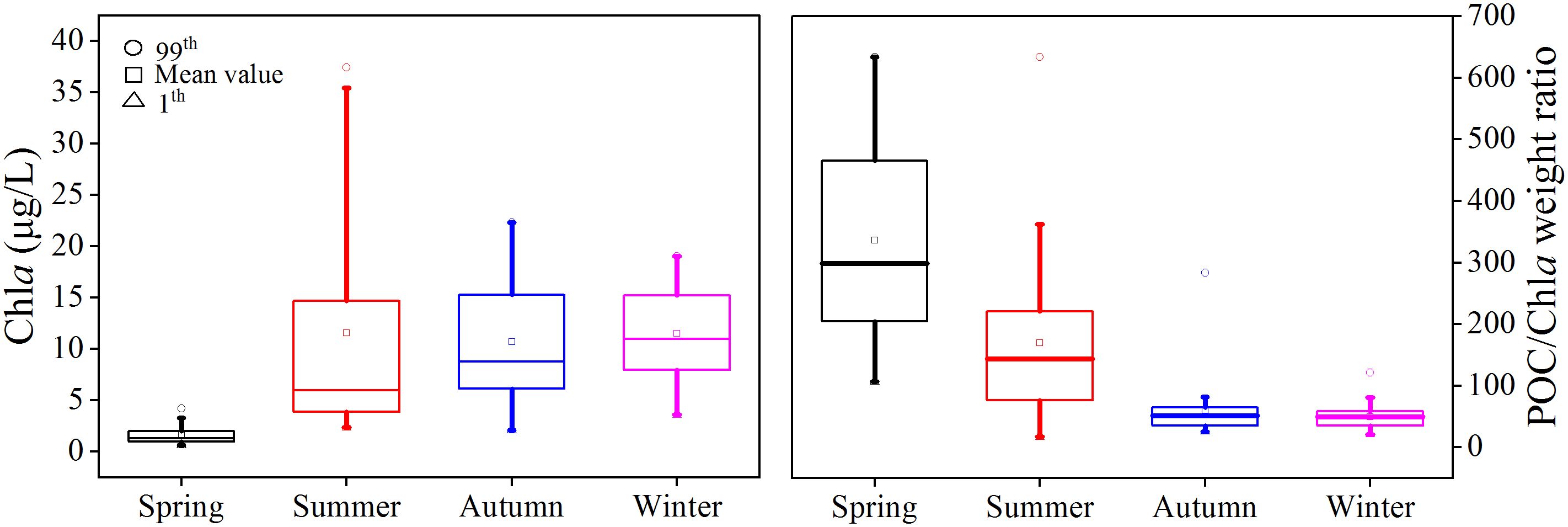
Figure 8 Average concentration of Chl a and POC/Chl a values in the surface water of Zhanjiang Bay in different seasons.
4 Discussion
4.1 The influence of physicochemical factors and climate factors on Chl a in different seasons
The concentration and composition of nutrients can have a significant impact on the growth of phytoplankton. Justin et al. and Dorch et al. proposed chemical dose limit standards for nutrients: if N/P < 10 and Si/N > 1, DIN is the limiting factor; if Si/P > 22 and N/P > 22, then PO4-P is the limiting factor; if Si/P < 10 and Si/N < 1, then SiO3-Si is the limiting factor, deviating from the corresponding ratio, and phytoplankton growth may be limited by insufficient nutrients (Dortch and Packard, 1989; Justić et al., 1995b). The average concentration of SiO3-Si in the surface water of Zhanjiang Bay in spring is 9.6 µmol/L, being just 0.30, 0.45, and 0.53 of the average concentration in summer, autumn, and winter, respectively (Figure 10, Table 1). The Si/P value in spring is 3/1 and Si/DIN is 0.6/1, so SiO3-Si is a key factor limiting the growth of surface phytoplankton in Zhanjiang Bay in spring, leading to a decrease in the concentration of Chl a (Figure 10), which also explains the significant positive correlation between Chl a and SiO3-Si. This result is consistent with other research results (Chen et al., 2021). In spring, the area of high Chl a in Zhanjiang Bay corresponds to the area of low PO4-P and DIN, indicating that PO4-P and DIN are not the main factors causing low concentrations of Chl a.
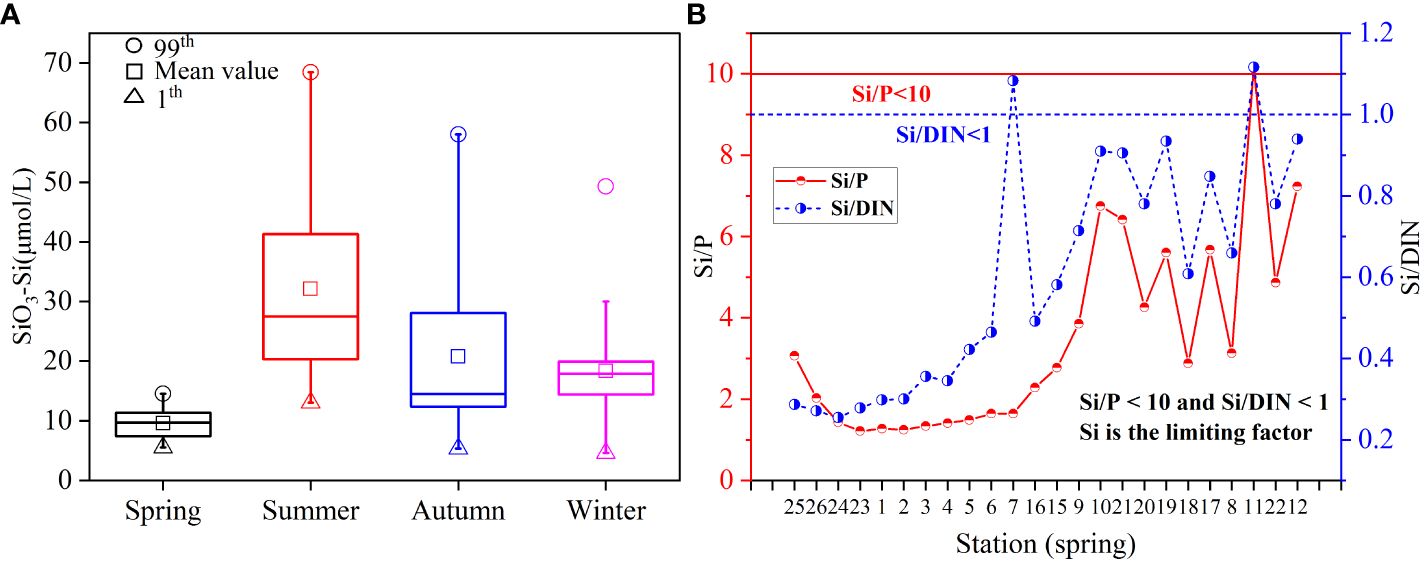
Figure 10 (A) Average concentration of SiO3-Si in the surface water of Zhanjiang Bay in different seasons (B) SiO3-Si/P 、SiO3-Si/DIN values in the surface water of Zhanjiang Bay in spring.
In summer, where there is abundant rainfall and high land runoff, coastal waters contain high concentrations of Chl a (Ho et al., 2010; Wang et al., 2022). Summer is the rainy season in Zhanjiang Bay, when discharge from the Suixi River is high. This brings point and surface source pollutants generated by land-based industry and agriculture into Zhanjiang Bay (Zhang et al., 2012; Shi et al., 2015). The average concentration of nutrients in the surface water of Zhanjiang Bay during summer is significantly higher than in other seasons (Table 1). In addition, the high temperature and intense light in the bay favor the growth of phytoplankton (He et al., 2023), so the average concentration of Chl a reaches the highest value of the year. Phytoplankton grows vigorously during summer and produces more DO. If the average concentration of Chl a in water exceeds 10 µg/L, the pH is mainly affected by photosynthesis by algae. As the mass of algae increases, the CO2 consumed by photosynthesis increases and the pH increases, showing a significant positive linear correlation with Chl a (Zang et al., 2011). In summer, the COD concentrations at stations Z11, Z22, and Z13, at mouth and outside of the bay, all exceeded 2 mg/L, much higher than in the middle of the bay. This may be related to the large quantity of organic pollutants discharged from the Baosteel sewage outlets and the large amount of land source pollutants discharged from the west coast of Guangdong that is carried by the current, resulting in a consistent spatiotemporal distribution of Chl a concentration and COD at the mouth and outside of the bay. In summer, the average concentrations of DIN and SiO3-Si increased by 119% and 234% compared with spring, respectively, while the average concentration of PO4-P only increased by 66% compared with spring. In addition, in areas with strong photosynthesis, algae proliferate extensively, and PO4-P in the water is also consumed to a great extent.
Zhanjiang Bay is located in the subtropical zone, with strong winter light and temperatures that remain high, which favor the growth of phytoplankton (He et al., 2023). On the other hand, winter is the dry season in the catchment of the Suixi River, which is a time of reducing river discharge. To maintain water balance in the bay, more water from outside of the bay enters the inside of the bay and the nutrient-rich coastal flow provides a substantial amount of nutrients, resulting in a high concentration of surface Chl a and the proliferation of algae in Zhanjiang Bay during winter. This leads to the consumption of nutrients in the water, a decrease in the concentration of SiO3-Si and DIN, and a significant negative correlation between Chl a and each of SiO3-Si and DIN. In the mixing area of freshwater and saltwater, the nutrient concentration is controlled by the mixing process. The nutrient mixing line can be obtained by connecting the freshwater and seawater endpoints on nutrient-salinity relationship diagram, as shown in Figure 11. A two end-member model shows that from top of the bay to the outside of the bay, SiO3-Si and DIN are depleted, while PO4-P is added (Figure 11). In recent years, the land-based emissions of PO4-P have been relatively high in Zhanjiang Bay (He et al., 2023). Therefore, although the phytoplankton grows vigorously in winter, the PO4-P concentration remains high after nutrient consumption. DIN: P and Si: P are both far less than 22 (Table 1), which also indicates that PO4-P concentration is not a limiting factor for phytoplankton production in winter. Therefore, climate conditions may be the dominant factor affecting winter Chl a.
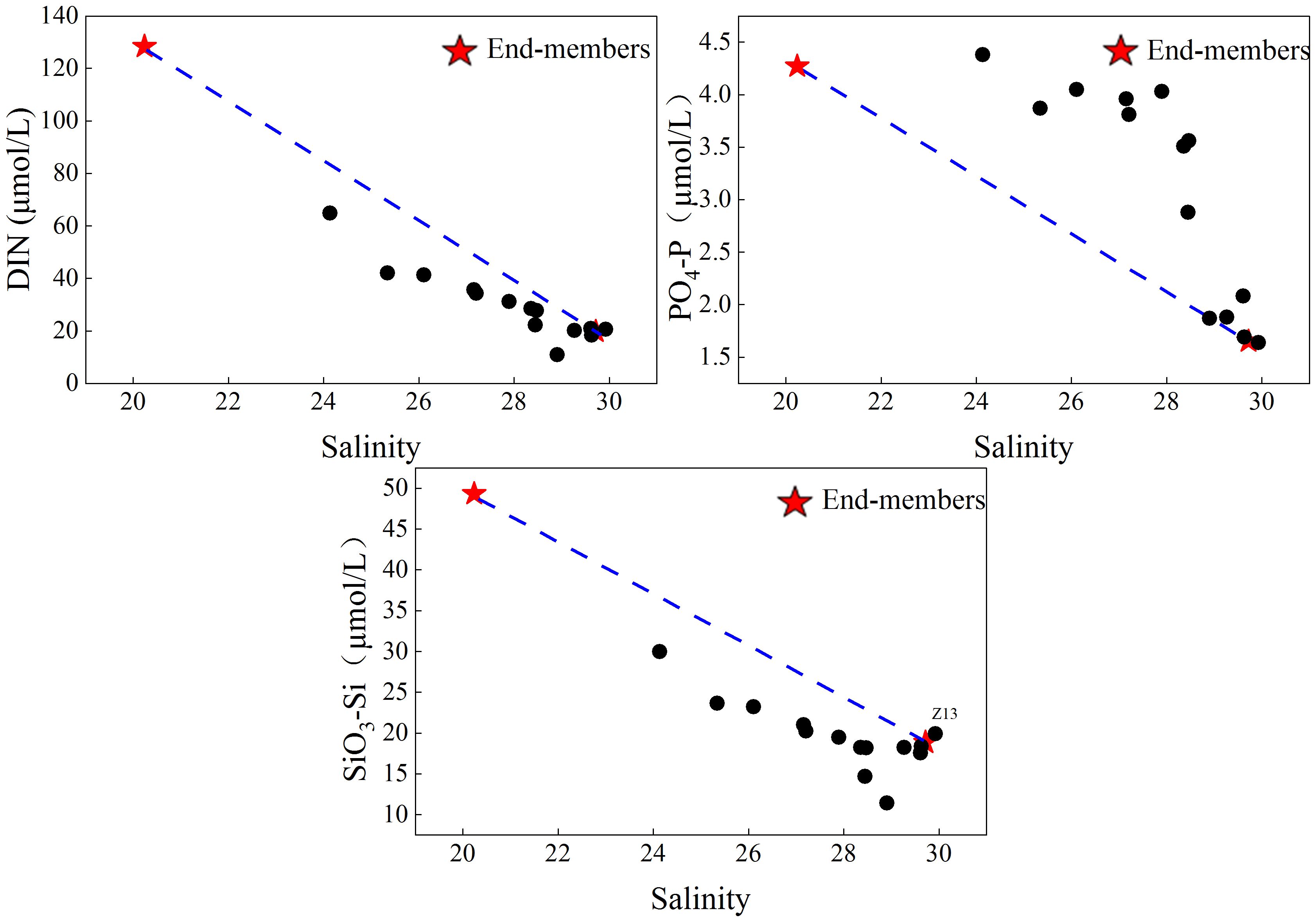
Figure 11 Relationships between nutrient concentrations and salinity in surface seawater of Zhanjiang Bay during winter.
Many studies have shown that POC in the nearshore area of the northern South China Sea is affected by the monsoon. During spring and summer, the water temperature rapidly increases due to the influence of the southwest monsoon, accelerating the stratification of seawater, weakening the vertical movement of upper and lower water masses, shallowing the ocean mixed layer, and making it difficult for deep nutrients to be carried to the surface, thereby limiting the in situ production of POC (Chen, 2005). In addition, due to the influence of the humid and hot airflow of the southwest monsoon, spring and summer are the rainy seasons in Zhanjiang Bay, with strong terrestrial erosion by rainwater, so more land-based materials are brought into the nearshore area (Zhang et al., 2021). In autumn and winter, influenced by the northeast monsoon, the surface water temperature decreases, the vertical mixing of seawater strengthens, and the ocean mixed layer deepens. Deep nutrients are more easily carried to the surface, thereby promoting the growth of marine phytoplankton (Chen and Chen, 2006), which consistent with the data of this study.
4.2 The influence of hydrodynamic conditions inside and outside of the bay on Chl a
The Chl a concentration in the surface water of Zhanjiang Bay in all seasons shows a decreasing trend from the top to the middle, and then to the mouth and outside of the bay. This is contrary to the spatial pattern of nutrients, indicating that the latter are not the main factor affecting Chl a. At the top of the bay, Z26 is located at the discharge outlet of the power plant, Z25 is located at the oyster breeding site, Z24 is located at the dock of the thermal power plant, and Z01–Z04 is located at the intersection of the waterway. The marine environment at the top of the bay is greatly affected by human activity, and at the same time, the bay is rich in nutrients due to the input of land-based runoff. However, there is a large area of aquaculture at the top of the bay and middle of the bay, especially the large-scale cultivation of oysters, where feeding and biological excretion have an effect. The concentration of suspended particulate matter at the top of the bay is relatively high, the transparency of the water body is reduced, the DO content is low, and photosynthesis is limited. In addition, the predation effect of oysters results in a relatively low Chl a. The inlet at the top of Zhanjiang Bay is narrow, with low water flow velocity and slow water exchange. The middle of the bay is more open, with greater water exchange. The mouth and outside of the bay are affected by tides that exchange large volumes of water (Wang et al., 2021). Many studies have shown that the coastal currents in western Guangdong directly affect runoff transport in the western Pearl River waters, and have an important impact on material transport, water quality, environmental factors, and fisheries and aquaculture in western Guangdong and even in the Beibu Gulf (Chen et al., 2021). The transparency of surface water has a great impact on the growth of phytoplankton (Wijewardene et al., 2021). The turbidity of the water at the mouth of Zhanjiang Bay and outside of the bay is low, and the transmittance is high (Li et al., 2020). The addition of eutrophic material from the Pearl River, carried by the coastal current, favors the growth of algae (Jian et al., 2022). Therefore, the concentration of Chl a is relatively high at the mouth and outside of the bay. In spring, weaker and narrower coastal currents transport insufficient nutrients to the nearshore, limiting the production of phytoplankton (Chen et al., 2021). Consequently, the concentration of Chl a is the lowest in spring. In summary, in addition to factors such as terrestrial nutrient transport, aquaculture, and climate, the geographical characteristics of Zhanjiang Bay may also result in a close relationship between Chl a and hydrodynamic conditions inside of the bay, as well as water masses outside of the bay.
5 Conclusions
(1) The average concentration of Chl a in the surface water of Zhanjiang Bay is highest in summer and lowest in spring (i.e., summer > winter > autumn > spring). The difference between summer and winter is relatively small, while the difference between summer and spring is significant.
(2) The Chl a concentration in the surface water of Zhanjiang Bay in all seasons shows a decreasing trend from the top through to the middle, mouth, and outside of the bay. This is different to the spatial distribution of nutrients, indicating that nutrients are not the dominant factor affecting Chl a.
(3) Due to the influence of the monsoon climate and terrestrial erosion by rainfall, the POC in Zhanjiang Bay in spring and summer is mainly affected by land-based inputs, while in situ phytoplankton production is the main source of POC in the surface water of Zhanjiang Bay in autumn and winter.
(4) Due to the special geographical location of Zhanjiang Bay, the dominant factors affecting the distribution of Chl a in the surface water of Zhanjiang Bay vary in different seasons, and are comprehensively influenced by terrestrial nutrient transport, artificial aquaculture, climate conditions, hydrodynamic conditions in the bay, and the coastal current of western Guangdong outside the bay.
Data availability statement
The raw data supporting the conclusions of this article will be made available by the authors, without undue reservation.
Author contributions
SW: Conceptualization, Formal analysis, Funding acquisition, Writing – original draft, Writing – review & editing. FZ: Conceptualization, Investigation, Methodology, Writing – original draft, Writing – review & editing. FC: Conceptualization, Funding acquisition, Supervision, Writing – review & editing. ZQ: Data curation, Methodology, Writing – review & editing. YM: Data curation, Methodology, Writing – review & editing.
Funding
The author(s) declare financial support was received for the research, authorship, and/or publication of this article. the Guangdong Basic and Applied Basic Research Foundation (2021A1515110172), the Program for Scientific Research Start-up Funds of Guangdong Ocean University (R20018), the National Natural Science Foundation of China (U1901213), the Guangdong Natural Science Foundation of China (2019B1515120066, 2016A030312004).
Conflict of interest
The authors declare that the research was conducted in the absence of any commercial or financial relationships that could be construed as a potential conflict of interest.
Publisher’s note
All claims expressed in this article are solely those of the authors and do not necessarily represent those of their affiliated organizations, or those of the publisher, the editors and the reviewers. Any product that may be evaluated in this article, or claim that may be made by its manufacturer, is not guaranteed or endorsed by the publisher.
References
Anderson S. I., Franzè G., Kling J. D., Wilburn P., Kremer C. T., Menden-Deuer S., et al. (2022). The interactive effects of temperature and nutrients on a spring phytoplankton community. Limnology Oceanography 67, 634–645. doi: 10.1002/lno.12023
Cai W. J., Feely R. A., Testa J. M., Li M., Evans W., Alin S. R., et al. (2021). Natural and anthropogenic drivers of acidification in large estuaries. Annu. Rev. Mar. Sci. 13, 23–55. doi: 10.1146/annurev-marine-010419-011004
Chen Y. L. L. (2005). Spatial and seasonal variations of nitrate-based new production and primary production in the South China Sea. Deep Sea Res. Part I: Oceanographic Res. Papers 52, 319–340. doi: 10.1016/j.dsr.2004.11.001
Chen Y. L. L., Chen H. Y. (2006). Seasonal dynamics of primary and new production in the northern South China Sea: The significance of river discharge and nutrient advection. Deep Sea Res. Part I: Oceanographic Res. Papers 53, 971–986. doi: 10.1016/j.dsr.2006.02.005
Chen F., Lu X., Song Z., Huang C., Jin G., Chen C., et al. (2021). Coastal currents regulate the distribution of the particulate organic matter in western Guangdong offshore waters as evidenced by carbon and nitrogen isotopes. Mar. pollut. Bull. 172, 112856. doi: 10.1016/j.marpolbul.2021.112856
Dortch Q., Packard T. T. (1989). Differences in biomass structure between oligotrophic and eutrophic marine ecosystems. Deep Sea Res. Part A. Oceanographic Res. Papers 36, 223–240. doi: 10.1016/0198-0149(89)90135-0
Duan H., Feng L., Ma R., Zhang Y., Loiselle S. A. (2014). Variability of particulate organic carbon in inland waters observed from MODIS Aqua imagery. Environ. Res. Lett. 9, 84011. doi: 10.1088/1748-9326/9/8/084011
Fu D., Zhong Y., Chen F., Yu G., Zhang X. (2020). Analysis of dissolved oxygen and nutrients in Zhanjiang Bay and the adjacent sea area in spring. Sustainability 12, 889. doi: 10.3390/su12030889
Golubkov M., Nikulina V., Golubkov S. (2021). Species-level associations of phytoplankton with environmental variability in the Neva Estuary (Baltic Sea). Oceanologia 63, 149–162. doi: 10.1016/j.oceano.2020.11.002
He G., Lao Q., Jin G., Zhu Q., Chen F. (2023). Increasing eutrophication driven by the increase of phosphate discharge in a subtropical bay in the past 30 years. Front. Mar. Sci. 10. doi: 10.3389/fmars.2023.1184421
Ho A. Y., Xu J., Yin K., Jiang Y., Yuan X., He L., et al. (2010). Phytoplankton biomass and production in subtropical Hong Kong waters: influence of the Pearl River outflow. Estuaries Coasts 33, 170–181. doi: 10.1007/s12237-009-9247-8
Jian X., Zhang S., Lao Q., Chen F., Huang P., Chen C., et al. (2022). Using dual water isotopes to quantify the mixing of water masses in the Pearl River Estuary and the adjacent northern South China Sea. Front. Mar. Sci., 987685. doi: 10.3389/fmars.2022.987685
Justić D., Rabalais N. N., Turner R. E. (1995b). Stoichiometric nutrient balance and origin of coastal eutrophication. Mar. Pollut. Bull. 30(1), 41–46. doi: 10.1016/0025-326X(94)00105-I
Justić D., Rabalais N. N., Turner R. E., Dortch Q. (1995a). Changes in nutrient structure of river-dominated coastal waters: stoichiometric nutrient balance and its consequences. Estuarine Coast. Shelf Sci. 40(3): 339–356. doi: 10.1016/S0272-7714(05)80014-9
Komorita T., Kobari T., Kume G., Sawada D., Nagata T., Habano A., et al. (2021). Spring phytoplankton blooms in the Northern Satsunan region, Japan, stimulated by the intrusion of Kuroshio Branch water. Estuarine Coast. Shelf Sci. 259, 107472. doi: 10.1016/j.ecss.2021.107472
Lao Q., Wu J., Chen F., Zhou X., Li Z., Chen C., et al. (2022). Increasing intrusion of high salinity water alters the mariculture activities in Zhanjiang Bay during the past two decades identified by dual water isotopes. J. Environ. Manage. 320, 115815. doi: 10.1016/j.jenvman.2022.115815
Le C., Lehrter J. C., Hu C., MacIntyre H., Beck M. W. (2017). Satellite observation of particulate organic carbon dynamics on the L ouisiana continental shelf. J. Geophysical Research: Oceans 122, 555–569. doi: 10.1002/2016JC012275
Li J., Cao R., Lao Q., Chen F., Chen C., Zhou X. (2020). Assessing seasonal nitrate contamination by nitrate dual isotopes in a monsoon-controlled bay with intensive human activities in South China. Int. J. Environ. Res. Public Health, 1921. doi: 10.3390/ijerph17061921
Li K., Liu L., Zhan J., Scippo M. L., Dalsgaard A. (2019). Evaluation of antimicrobial products used in tilapia (Oreochromis spp.) and whiteleg shrimp (Litopenaeus vannamei) aquaculture. Aquaculture Res. 50, 925–933. doi: 10.1111/are.13967
Liu X., Laws E. A., Xie Y., Wang L., Lin L., Huang B. (2019). Uncoupling of seasonal variations between phytoplankton chlorophyll a and production in the East China Sea. J. Geophysical Research: Biogeosciences 124, 2400–2415. doi: 10.1029/2018JG004924
Lucas S. N., Fouad G., Adolf J. E. (2023). Spatially distributed water quality responses to freshwater discharge in a tropical estuary, Hilo Bay, Hawai’i. Environ. Monit. Assess. 195, 428. doi: 10.1007/s10661-023-11006-1
Minu A., Routh J., Machiwa J. F., Pamba S. (2020). Spatial variation of nutrients and primary productivity in the RuFiji Delta mangroves, Tanzania. Afr. J. Mar. Sci. 42, 221–232. doi: 10.2989/1814232X.2020.1776391
Niveditha S. K., Haridevi C. K., Hardikar R., Ram A. (2022). Phytoplankton assemblage and chlorophyll a along the salinity gradient in a hypoxic eutrophic tropical estuary-Ulhas Estuary, West Coast of India. Mar. pollut. Bull. 180, 113719. doi: 10.1016/j.marpolbul.2022.113719
Ogawa Y., Okamoto Y., Sadaba R. B., Kanzaki M. (2021). Sediment organic matter source estimation and ecological classification in the semi-enclosed Batan Bay Estuary, Philippines. Int. J. Sediment Res. 36, 110–119. doi: 10.1016/j.ijsrc.2020.05.007
Savoye N., David V., Morisseau F., Etcheber H., Abril G., Billy I., et al. (2012). Origin and composition of particulate organic matter in a macrotidal turbid estuary: The Gironde Estuary, France. Estuarine Coast. Shelf Sci. 108, 16–28. doi: 10.1016/j.ecss.2011.12.005
Shi Y., Zhang Y., Sun X. (2015). Spatiotemporal distribution of eutrophication and its relationship with environmental factors in Zhanjiang Bay area. Environ. Sci. Technol. 38, 90–96.
Wang Y. H., Chen J. F., Zhou F., Zhang W., Hao Q. (2022). Spatial and temporal variations of chlorophyll a and primary productivity in the Hangzhou Bay. J. Mar. Sci. Eng. 10, 356. doi: 10.3390/jmse10030356
Wang S., Zhou F., Chen F., Meng Y., Zhu Q. (2021). Spatiotemporal distribution characteristics of nutrients in the drowned tidal inlet under the influence of tides: A case study of Zhanjiang bay, China. Int. J. Environ. Res. Public Health 18, 2089. doi: 10.3390/ijerph18042089
Wijewardene L., Wu N., Qu Y., Guo K., Messyasz B., Lorenz S., et al. (2021). Influences of pesticides, nutrients, and local environmental variables on phytoplankton communities in lentic small water bodies in a German lowland agricultural area. Sci. Total Environ. 780, 146481. doi: 10.1016/j.scitotenv.2021.146481
Wu X. Y., Yang Y. F. (2011). Heavy metal (Pb, Co, Cd, Cr, Cu, Fe, Mn and Zn) concentrations in harvest-size white shrimp Litopenaeus vannamei tissues from aquaculture and wild source. J. Food Composition Anal. 24, 62–65. doi: 10.1016/j.jfca.2010.03.030
Zang C., Huang S., Wu M., Du S., Scholz M., Gao F., et al. (2011). ). Comparison of relationships between pH, dissolved oxygen and chlorophyll a for aquaculture and non-aquaculture waters. Water Air Soil pollut. 219, 157–174. doi: 10.1007/s11270-010-0695-3
Zhang P., Xu J. L., Zhang J. B., Li J. X., Zhang Y. C., Li Y., et al. (2020). Spatiotemporal dissolved silicate variation, sources, and behavior in the eutrophic Zhanjiang Bay, China. Water 12, 3586. doi: 10.3390/w12123586
Zhang J., Zhang Y., Sun X. (2012). The spatial and temporal distributions of chlorophyll-a and its relationship with main environmental factors in Zhanjiang Bay in 2009. Adv. Mar. Sci. 30, 236–243.
Zhang J., Zhang Y., Zhang P., Li Y., Li J., Luo X., et al. (2021). Seasonal phosphorus variation in coastal water affected by the land-based sources input in the eutrophic Zhanjiang Bay, China. Estuarine Coast. Shelf Sci. 252, 107277. doi: 10.1016/j.ecss.2021.107277
Keywords: Zhanjiang Bay, chlorophyll a, nutrient, environmental factor, particulate organic carbon
Citation: Wang S, Zhou F, Chen F, Zhu Q and Meng Y (2024) Spatial and seasonal variations of chlorophyll a in Zhanjiang Bay, China, and controlling factors. Front. Mar. Sci. 11:1329864. doi: 10.3389/fmars.2024.1329864
Received: 30 October 2023; Accepted: 01 February 2024;
Published: 07 June 2024.
Edited by:
Ricardo Torres, Plymouth Marine Laboratory, United KingdomReviewed by:
Bin Yang, Jiangsu Ocean Universiity, ChinaCatherine Mitchell, Bigelow Laboratory For Ocean Sciences, United States
Copyright © 2024 Wang, Zhou, Chen, Zhu and Meng. This is an open-access article distributed under the terms of the Creative Commons Attribution License (CC BY). The use, distribution or reproduction in other forums is permitted, provided the original author(s) and the copyright owner(s) are credited and that the original publication in this journal is cited, in accordance with accepted academic practice. No use, distribution or reproduction is permitted which does not comply with these terms.
*Correspondence: Fengxia Zhou, Znh6aG91QGdkb3UuZWR1LmNu
 Shuangling Wang
Shuangling Wang Fengxia Zhou
Fengxia Zhou Fajin Chen
Fajin Chen Qingmei Zhu
Qingmei Zhu Yafei Meng1,2,3
Yafei Meng1,2,3